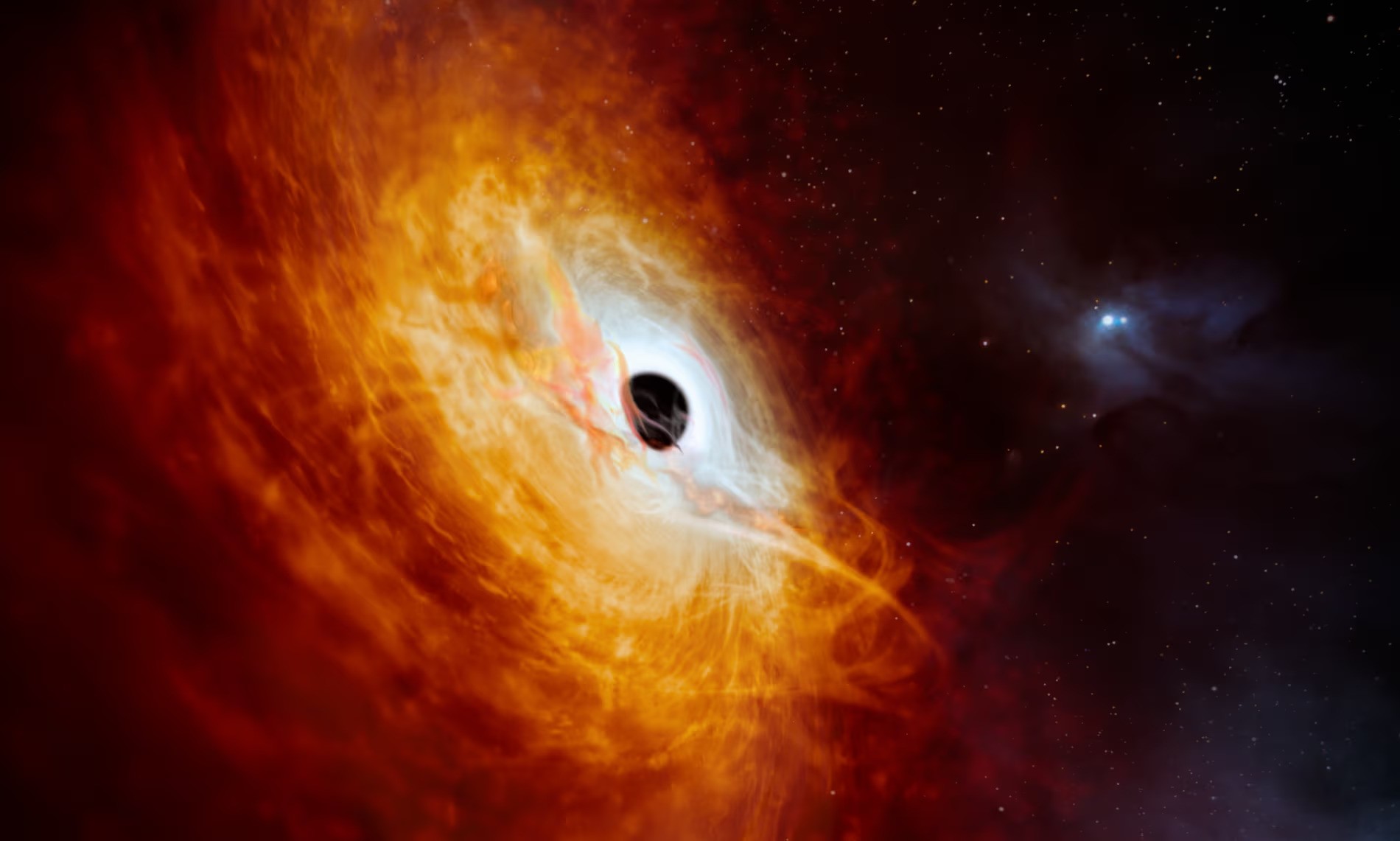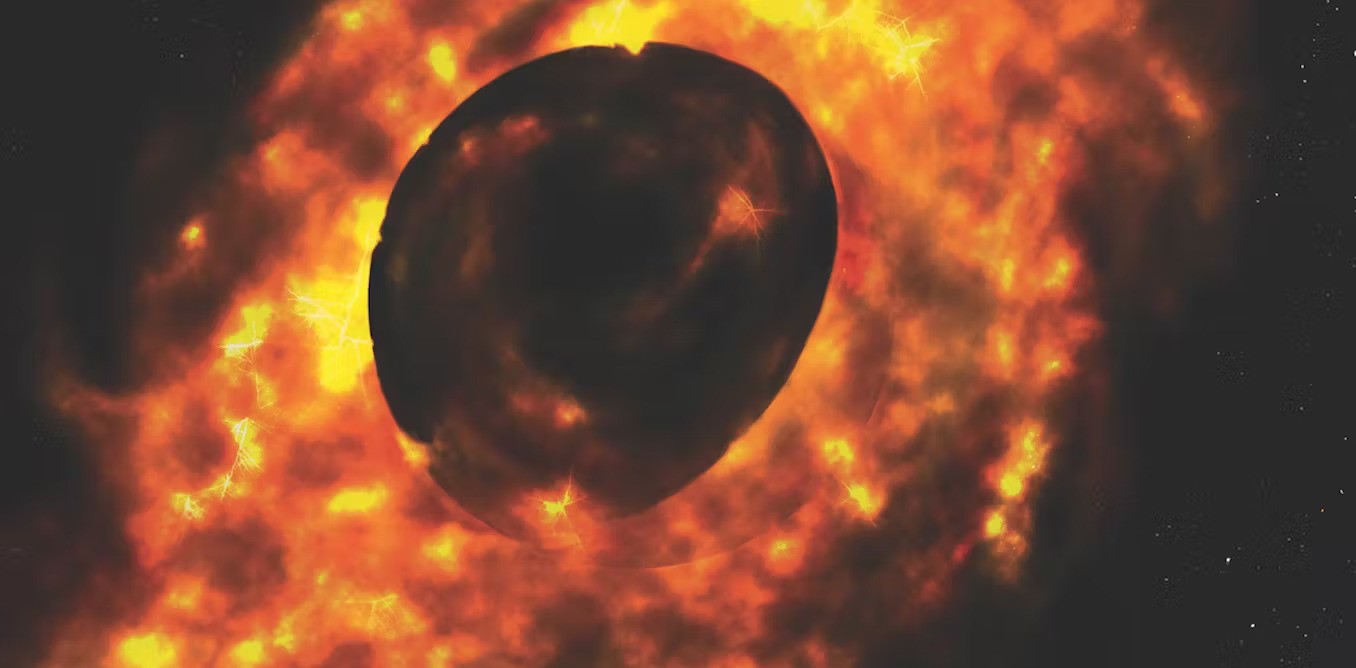Astronomers Discover Universe's Brightest Object Fueled By A Black Hole That Devours A Sun Daily
Astronomers discover universe's brightest object fueled by a black hole that devours a sun daily. Using the European Southern Observatory's (ESO) Very Large Telescope (VLT), astronomers scrutinized the brilliant quasar and determined it to not only be the brightest of its kind but also the most luminous object ever documented.
Author:Hajra ShannonReviewer:Paula M. GrahamFeb 21, 2024263 Shares26.3K Views

Astronomers discover universe's brightest object fueled by a black hole that devours a sun daily. Using the European Southern Observatory's (ESO) Very Large Telescope (VLT), astronomers scrutinized the brilliant quasar and determined it to not only be the brightest of its kind but also the most luminous object ever documented. Quasars are the radiant cores of galaxies far away, powered by supermassive black holes.
The black hole at the heart of this exceptional quasar is rapidly gaining mass, equivalent to one solar mass per day, marking it as the fastest-growing black hole discovered to date.
These black holes, propelling quasars, gather matter from their surroundings in a high-energy process that emits immense amounts of light. Their brilliance makes quasars some of the most conspicuous objects in our sky, visible even from great distances. Typically, the most luminous quasars signify the swiftest-growing supermassive black holes.
"We have discovered the fastest-growing black hole known to date. It has a mass of 17 billion suns and eats just over a sun per day. This makes it the most luminous object in the known universe," says Christian Wolf, an astronomer at the Australian National University (ANU) and lead author of the study published Nature Astronomy. The quasar, called J0529-4351, is so far away from Earth that its light took over 12 billion years to reach us.
The matter spiraling into this black hole, forming a disk, emits such an immense amount of energy that J0529-4351 shines over 500 trillion times brighter than the sun. "All this light comes from a hot accretion disk that measures seven light-years in diameter - this must be the largest accretion disk in the universe," explains Samuel Lai, a Ph.D. student at ANU and co-author of the study. To put it in perspective, seven light-years equals roughly 15,000 times the distance from the sun to Neptune's orbit.
Surprisingly, this groundbreaking quasar remained unnoticed until now. "It is a surprise that it has remained unknown until today when we already know about a million less impressive quasars. It has been staring us in the face until now," remarks co-author Christopher Onken, an astronomer at ANU. He adds that this object appeared in images from the ESO Schmidt Southern Sky Survey as far back as 1980, but its true nature as a quasar wasn't recognized until decades later.
Identifying quasars demands meticulous observational data covering vast swathes of the sky. The datasets produced are immense, prompting researchers to employ machine-learning algorithms to sift through them and distinguish quasars from other cosmic entities.
Yet, these algorithms rely on pre-existing data for training, constraining potential discoveries to objects resembling those already cataloged. Should a newly discovered quasar outshine any previously documented, the algorithm might mistakenly classify it as a nearby star rather than recognizing its true nature.
An automated analysis of data from the European Space Agency's Gaia satellite initially dismissed J0529-4351 as too bright to be a quasar, suggesting it to be a star instead. It wasn't until last year that researchers, using observations from the ANU 2.3-meter telescope at the Siding Spring Observatory in Australia, identified it as a distant quasar.
However, confirming it as the most luminous quasar ever observed required a larger telescope and more precise measurements. Crucial data came from the X-shooter spectrograph on ESO's VLT in the Chilean Atacama Desert.
The fastest-growing black hole ever observed will also become a prime target for the GRAVITY+ upgrade on ESO's VLT Interferometer (VLTI). This upgrade is tailored to accurately measure the mass of black holes, even those located far from Earth. Furthermore, ESO's Extremely Large Telescope (ELT), a 39-meter telescope currently being constructed in the Chilean Atacama Desert, will significantly enhance the identification and characterization of such elusive objects.
Discovering and examining distant supermassive black holes holds the potential to unravel the mysteries of the early universe, offering insights into the formation and evolution of these cosmic giants and their host galaxies. However, for Wolf, the pursuit of these elusive entities is driven by more than just scientific curiosity. "Personally, I simply like the chase," he says. "For a few minutes a day, I get to feel like a child again, playing treasure hunt, and now I bring everything to the table that I have learned since."
The black hole at the heart of this exceptional quasar is rapidly gaining mass, equivalent to one solar mass per day, marking it as the fastest-growing black hole discovered to date.
These black holes, propelling quasars, gather matter from their surroundings in a high-energy process that emits immense amounts of light. Their brilliance makes quasars some of the most conspicuous objects in our sky, visible even from great distances. Typically, the most luminous quasars signify the swiftest-growing supermassive black holes.
"We have discovered the fastest-growing black hole known to date. It has a mass of 17 billion suns and eats just over a sun per day. This makes it the most luminous object in the known universe," says Christian Wolf, an astronomer at the Australian National University (ANU) and lead author of the study published Nature Astronomy. The quasar, called J0529-4351, is so far away from Earth that its light took over 12 billion years to reach us.
The matter spiraling into this black hole, forming a disk, emits such an immense amount of energy that J0529-4351 shines over 500 trillion times brighter than the sun. "All this light comes from a hot accretion disk that measures seven light-years in diameter - this must be the largest accretion disk in the universe," explains Samuel Lai, a Ph.D. student at ANU and co-author of the study. To put it in perspective, seven light-years equals roughly 15,000 times the distance from the sun to Neptune's orbit.
Surprisingly, this groundbreaking quasar remained unnoticed until now. "It is a surprise that it has remained unknown until today when we already know about a million less impressive quasars. It has been staring us in the face until now," remarks co-author Christopher Onken, an astronomer at ANU. He adds that this object appeared in images from the ESO Schmidt Southern Sky Survey as far back as 1980, but its true nature as a quasar wasn't recognized until decades later.
Identifying quasars demands meticulous observational data covering vast swathes of the sky. The datasets produced are immense, prompting researchers to employ machine-learning algorithms to sift through them and distinguish quasars from other cosmic entities.
Yet, these algorithms rely on pre-existing data for training, constraining potential discoveries to objects resembling those already cataloged. Should a newly discovered quasar outshine any previously documented, the algorithm might mistakenly classify it as a nearby star rather than recognizing its true nature.
An automated analysis of data from the European Space Agency's Gaia satellite initially dismissed J0529-4351 as too bright to be a quasar, suggesting it to be a star instead. It wasn't until last year that researchers, using observations from the ANU 2.3-meter telescope at the Siding Spring Observatory in Australia, identified it as a distant quasar.
However, confirming it as the most luminous quasar ever observed required a larger telescope and more precise measurements. Crucial data came from the X-shooter spectrograph on ESO's VLT in the Chilean Atacama Desert.
The fastest-growing black hole ever observed will also become a prime target for the GRAVITY+ upgrade on ESO's VLT Interferometer (VLTI). This upgrade is tailored to accurately measure the mass of black holes, even those located far from Earth. Furthermore, ESO's Extremely Large Telescope (ELT), a 39-meter telescope currently being constructed in the Chilean Atacama Desert, will significantly enhance the identification and characterization of such elusive objects.
Discovering and examining distant supermassive black holes holds the potential to unravel the mysteries of the early universe, offering insights into the formation and evolution of these cosmic giants and their host galaxies. However, for Wolf, the pursuit of these elusive entities is driven by more than just scientific curiosity. "Personally, I simply like the chase," he says. "For a few minutes a day, I get to feel like a child again, playing treasure hunt, and now I bring everything to the table that I have learned since."

Hajra Shannon
Author

Paula M. Graham
Reviewer
Latest Articles
Popular Articles
